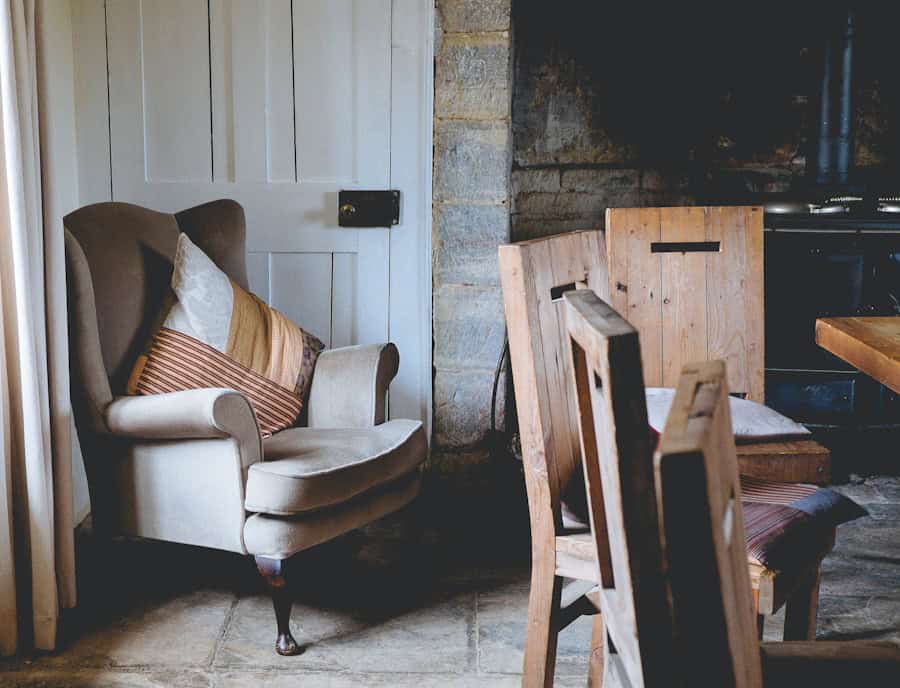Reclaimed wood is a sustainable and environmentally friendly option for interior design and furniture. By using reclaimed wood, we are able to reduce the demand for new timber, which in turn helps to preserve forests and natural habitats. The process of sourcing and using reclaimed wood also helps to reduce the amount of waste that ends up in landfills. Instead of allowing old wood to go to waste, it can be repurposed and given a new life, reducing the need for new materials and minimizing the environmental impact of production.
In addition, using reclaimed wood helps to reduce the carbon footprint associated with the production of new wood products. When trees are cut down and processed into lumber, it requires a significant amount of energy and resources. By using reclaimed wood, we are able to minimize the energy and resources required for production, making it a more sustainable option. Overall, the use of reclaimed wood in interior design and furniture has a positive impact on the environment, making it an attractive choice for those who are conscious of their ecological footprint.
The Versatility of Reclaimed Wood in Interior Design
One of the most appealing aspects of reclaimed wood is its versatility in interior design. Reclaimed wood can be used in a variety of ways, from flooring and wall paneling to furniture and decorative accents. Its natural beauty and unique character make it a popular choice for adding warmth and texture to any space. Whether used in a modern, minimalist setting or a rustic, farmhouse-style interior, reclaimed wood has the ability to complement a wide range of design styles.
In addition to its aesthetic appeal, reclaimed wood is also prized for its durability and longevity. When properly sourced and treated, reclaimed wood can be just as strong and resilient as new timber, making it a practical choice for high-traffic areas and furniture pieces. Its ability to withstand wear and tear while maintaining its natural charm makes it a versatile and reliable material for interior design. Whether used as a focal point or as a subtle accent, reclaimed wood has the ability to enhance the visual appeal and functionality of any space.
The Popularity of Reclaimed Wood Furniture
Reclaimed wood furniture has become increasingly popular in recent years, as more people seek out sustainable and unique pieces for their homes. The appeal of reclaimed wood furniture lies in its one-of-a-kind character and history. Each piece of reclaimed wood furniture tells a story, with its weathered patina and distinctive markings adding to its charm and allure. Whether it’s a reclaimed wood dining table or a set of chairs, each piece brings a sense of authenticity and individuality to a space.
In addition to its aesthetic appeal, reclaimed wood furniture is also valued for its environmental benefits. By choosing reclaimed wood furniture, consumers are able to support sustainable practices and reduce their impact on the environment. This has led to an increased demand for reclaimed wood furniture, as more people become aware of the importance of making eco-friendly choices in their homes. As a result, there is now a wide range of reclaimed wood furniture available on the market, catering to different design preferences and functional needs.
The Appeal of Reclaimed Wood in Modern and Rustic Design
Reclaimed wood has a timeless appeal that transcends design trends, making it a popular choice for both modern and rustic interiors. In modern design, reclaimed wood adds warmth and character to sleek, minimalist spaces, creating a sense of balance and contrast. Its natural texture and organic feel can soften the clean lines and sharp angles often associated with modern design, creating a more inviting and harmonious atmosphere.
On the other hand, in rustic design, reclaimed wood is a natural fit, adding to the cozy and inviting ambiance that is characteristic of this style. Whether used for flooring, wall paneling, or furniture, reclaimed wood brings a sense of history and authenticity to rustic interiors. Its weathered appearance and rich patina create a sense of nostalgia and comfort, evoking the charm of a bygone era. The versatility of reclaimed wood in both modern and rustic design makes it a highly sought-after material for interior spaces.
The Process of sourcing and treating Reclaimed Wood
The process of sourcing and treating reclaimed wood is an important aspect of ensuring its quality and longevity. Reclaimed wood is typically sourced from old buildings, barns, or other structures that are being demolished or renovated. Once the wood is salvaged, it undergoes a thorough inspection to assess its condition and determine its suitability for reuse. Any nails, screws, or other metal hardware are removed, and the wood is then carefully cleaned and treated to remove any dirt, debris, or contaminants.
After the initial cleaning process, the reclaimed wood is inspected for any signs of damage or decay. Any areas that are compromised are carefully repaired or replaced to ensure the structural integrity of the wood. Once the necessary repairs have been made, the reclaimed wood is then treated with protective finishes to enhance its durability and resistance to wear. This may include applying sealants or oils to protect the surface of the wood from moisture, stains, and other potential damage.
The Economic Benefits of Using Reclaimed Wood
In addition to its environmental benefits, using reclaimed wood also offers economic advantages. By using reclaimed wood in interior design and furniture production, we are able to reduce the demand for new timber, which in turn helps to lower the cost of new materials. This can result in cost savings for consumers who choose reclaimed wood products over new ones. In addition, using reclaimed wood can also help to stimulate local economies by supporting small businesses that specialize in salvaging and repurposing old wood.
Furthermore, using reclaimed wood can also add value to a property or space. Reclaimed wood is often perceived as a premium material due to its unique character and sustainability, making it an attractive feature for potential buyers or tenants. Whether used for flooring, cabinetry, or decorative accents, reclaimed wood has the ability to enhance the overall appeal and marketability of a space. This can be particularly beneficial for homeowners or businesses looking to increase the value of their property or create a more desirable environment for customers or guests.
The Future of Reclaimed Wood in Interior Design
The future of reclaimed wood in interior design looks promising as more people become aware of the environmental impact of their choices. With an increasing focus on sustainability and eco-friendly practices, there is a growing demand for materials that are both aesthetically pleasing and environmentally responsible. Reclaimed wood fits this criteria perfectly, offering a unique blend of beauty, durability, and sustainability that appeals to a wide range of consumers.
As awareness of the benefits of using reclaimed wood continues to grow, we can expect to see an even greater variety of reclaimed wood products available on the market. This includes everything from flooring and wall paneling to furniture and decorative accessories. Additionally, as technology advances, we may see new methods for sourcing and treating reclaimed wood that further enhance its quality and performance. Ultimately, the future of reclaimed wood in interior design looks bright as it continues to be embraced by designers, homeowners, and businesses alike.




